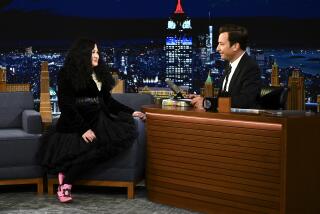News That Stayed News : TEN YEARS OF COEVOLUTION QUARTERLY, edited by Art Kleiner and Stewart Brand (North Point: $30, hardcover; $13.95, paperback; 337 pp.)
- Share via
In the lead article in this collection, biologist Paul R. Ehrlich reports, on the basis of his insect studies, that predators and their prey evolve in close relationship with each other; eaters are inextricably involved with the eaten, and vice versa. The concluding paragraph suggests, with a modesty reminiscent of Watson & Crick’s paper on DNA, that much of evolutionary biology will have to be rethought as a consequence.
There was also a journalistic consequence, a name for a magazine founded 11 years ago by Stewart Brand: “CoEvolution Quarterly.” CEQ, lately reborn as “The Whole Earth Review,” after Brand’s well-remembered catalogue, reflects its creator’s ability to recognize the startlingly new even as it betrays his weakness for charming intellectual scoundrels like the late Herman Kahn.
The latter tendency is manifested in this collection by a discussion involving Kahn, then-Gov. Jerry Brown and Amory Lovins, set up by Brand when he was Brown’s special assistant. (His job was to lasso idea-mongers and expose them to people in the state government through brown-bag lunches--a characteristic Brand project.) Kahn had read Milovan Djilas’ “The New Class” on the bureaucrats who, in East Bloc countries, had managed to seize the means of production. Kahn stripped the term of its Marxist meaning and used it to signify “all those snotty American intellectuals I don’t like.”
This was an entertaining conversational gambit, but serious new thinking--on the level of Gregory Bateson or Margulis/Lovelock or Ray Dasmann or other towering figures from CEQ’s pages--it was not. I am not sure whether Brand knew then, or realizes now, that he is easily bored by politics. But in any case, he wouldn’t care. To his mind, Kahn was interesting , and that’s what counted. Brand knows instinctively that mental temperance is a vice.
What’s most remarkable about CEQ is not that it has given voice to a lot of novel ideas--so has Science magazine, after all--but its mode of doing so: candid, informal, direct, humorous, succinct, conversational writing, with a very low BS-quotient. Brand sometimes referred to this as “Learning Mode,” and most of what’s collected here exemplifies how exciting it can be. Thus J. Baldwin talks about the usefulness of failure (for experimenters and designers, but implicitly for any aspect of life); Brand talks with Bruce Ames about human-caused damage to DNA; Gary Snyder meditates on relationships between the wild and the sacred.
CEQ sometimes printed fiction, but this is an area where Brand’s taste is mysteriously erratic, and none of his choices has survived into this anthology. However, one kind of writing included here borders on fiction, for instance Leo Dreu’s “Rachelann: A Remembrance” or Will Baker’s “The Legend of Great Uncle Jim and the Woman Behind It All,” in which the CEQ virtues of direct address and self-exposure proved powerful literary tools.
“News That Stayed News” is a three-ring circus of writing, a treat for anybody who enjoys juggling ideas or going out on the intellectual high wire without a net.
More to Read
Sign up for our Book Club newsletter
Get the latest news, events and more from the Los Angeles Times Book Club, and help us get L.A. reading and talking.
You may occasionally receive promotional content from the Los Angeles Times.




